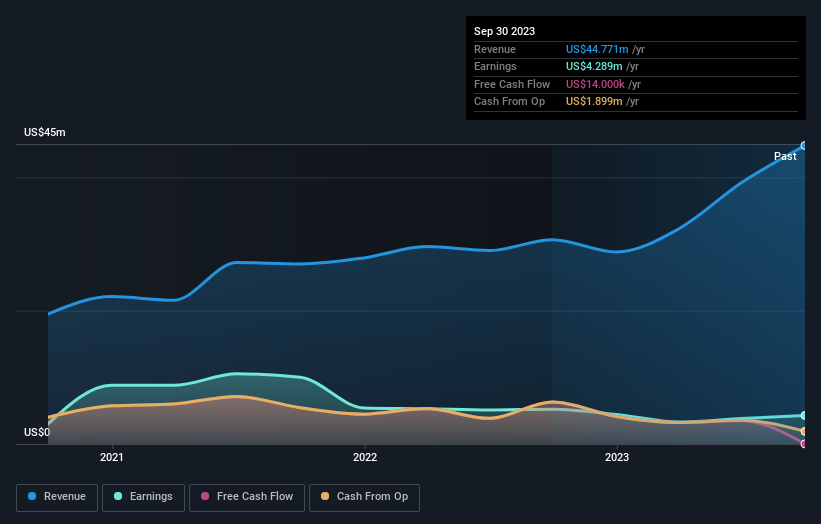Hedge funds investors have a lot riding on FitLife Brands, Inc. (NASDAQ:FTLF) with 45% ownership
Key Insights
Given the large stake in the stock by institutions, FitLife Brands' stock price might be vulnerable to their trading decisions
A total of 2 investors have a majority stake in the company with 56% ownership
To get a sense of who is truly in control of FitLife Brands, Inc. (NASDAQ:FTLF), it is important to understand the ownership structure of the business. And the group that holds the biggest piece of the pie are hedge funds with 45% ownership. Put another way, the group faces the maximum upside potential (or downside risk).
Last week’s 11% gain means that hedge funds investors were on the positive end of the spectrum even as the company has shown strong longer-term trends. The one-year return on investment is currently 35% and last week's gain would have been more than welcomed.
Let's delve deeper into each type of owner of FitLife Brands, beginning with the chart below.
View our latest analysis for FitLife Brands
What Does The Institutional Ownership Tell Us About FitLife Brands?
Institutional investors commonly compare their own returns to the returns of a commonly followed index. So they generally do consider buying larger companies that are included in the relevant benchmark index.
Less than 5% of FitLife Brands is held by institutional investors. This suggests that some funds have the company in their sights, but many have not yet bought shares in it. If the company is growing earnings, that may indicate that it is just beginning to catch the attention of these deep-pocketed investors. We sometimes see a rising share price when a few big institutions want to buy a certain stock at the same time. The history of earnings and revenue, which you can see below, could be helpful in considering if more institutional investors will want the stock. Of course, there are plenty of other factors to consider, too.
It looks like hedge funds own 45% of FitLife Brands shares. That catches my attention because hedge funds sometimes try to influence management, or bring about changes that will create near term value for shareholders. Sudbury Capital Management, LLC is currently the company's largest shareholder with 45% of shares outstanding. Dayton Judd is the second largest shareholder owning 11% of common stock, and Horizon Kinetics LLC holds about 1.7% of the company stock. Dayton Judd, who is the second-largest shareholder, also happens to hold the title of Chief Executive Officer.
After doing some more digging, we found that the top 2 shareholders collectively control more than half of the company's shares, implying that they have considerable power to influence the company's decisions.
While it makes sense to study institutional ownership data for a company, it also makes sense to study analyst sentiments to know which way the wind is blowing. As far as we can tell there isn't analyst coverage of the company, so it is probably flying under the radar.
Insider Ownership Of FitLife Brands
The definition of company insiders can be subjective and does vary between jurisdictions. Our data reflects individual insiders, capturing board members at the very least. Company management run the business, but the CEO will answer to the board, even if he or she is a member of it.
Insider ownership is positive when it signals leadership are thinking like the true owners of the company. However, high insider ownership can also give immense power to a small group within the company. This can be negative in some circumstances.
Our information suggests that insiders maintain a significant holding in FitLife Brands, Inc.. Insiders own US$14m worth of shares in the US$101m company. This may suggest that the founders still own a lot of shares. You can click here to see if they have been buying or selling.
General Public Ownership
The general public-- including retail investors -- own 40% stake in the company, and hence can't easily be ignored. This size of ownership, while considerable, may not be enough to change company policy if the decision is not in sync with other large shareholders.
Next Steps:
I find it very interesting to look at who exactly owns a company. But to truly gain insight, we need to consider other information, too. Case in point: We've spotted 2 warning signs for FitLife Brands you should be aware of, and 1 of them is concerning.
Of course, you might find a fantastic investment by looking elsewhere. So take a peek at this free list of interesting companies.
NB: Figures in this article are calculated using data from the last twelve months, which refer to the 12-month period ending on the last date of the month the financial statement is dated. This may not be consistent with full year annual report figures.
Have feedback on this article? Concerned about the content? Get in touch with us directly. Alternatively, email editorial-team (at) simplywallst.com.
This article by Simply Wall St is general in nature. We provide commentary based on historical data and analyst forecasts only using an unbiased methodology and our articles are not intended to be financial advice. It does not constitute a recommendation to buy or sell any stock, and does not take account of your objectives, or your financial situation. We aim to bring you long-term focused analysis driven by fundamental data. Note that our analysis may not factor in the latest price-sensitive company announcements or qualitative material. Simply Wall St has no position in any stocks mentioned.


